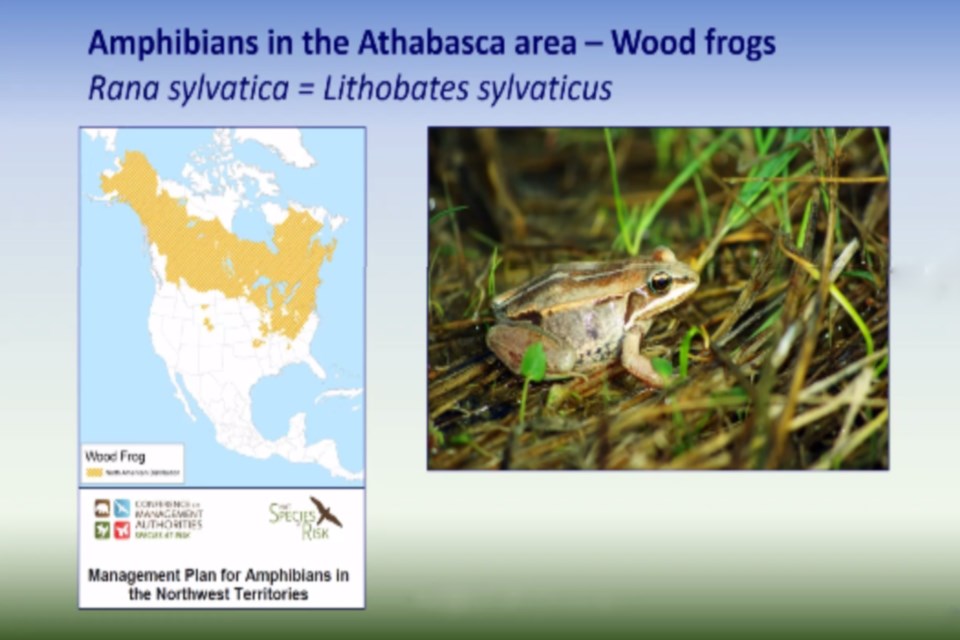ATHABASCA - They're cold-blooded and they're thin-skinned, but that's pretty typical for an amphibian.
Everything you ever wanted to know about local amphibians, was the topic of discussion at Science Outreach - Athabasca's latest educational endeavour April 13 and was attended by over 70 people online.
Dr. Danna Schock, a biologist, spoke about frogs, toads and salamanders that can, or should, be found in the greater Athabasca region, noting although she has not seen salamanders in the area herself, they should be here.
“Some other characteristics of amphibians that are important to note is that they have very thin, permeable skin and that means that things come and go very easily,” said Schock. “Amphibians use that to their advantage because they use it for water absorption and gas exchange. Amphibians tend to dump the CO2 (carbon dioxide) out of their blood. Oxygen into their lungs, CO2 dumped out through their skin.”
They have no scales, claws, teeth or fur and they are called cold-blooded, Schock said, but explained that’s a bit of a misnomer because they use the environment to regulate body temperature by basking in the sun, or finding warm areas in the water.
“When you say cold-blooded, I think it doesn't really relate,” she said. “It doesn't relate the complexity of what they're actually doing and how they're behaving in their environment.”
And not all amphibians are the same in how they interact with the environment to survive she said, listing three frogs that have very different ways of surviving through the winter, or over-wintering.
“The Leopard frog over-winters in the deep cold water where it doesn't go anoxic. The toad burrows down into the soil and gets underneath the frost line, and then the Wood frogs actually freeze solid under a layer of snow,” said Schock. “But that means that snow pack has to stay intact the entire time in the winter, because under about 30 centimetres of snow it actually isn't -30 there, it's about -3, as long as that snow pack is on top.”
What that also means is for those three to exist in the same area the conditions of water, trees and snow must be met, which is why amphibians are a good indicator of ecological integrity.
“Amphibians as a whole, they're not doing so hot,” she said. “There's about seven or 8,000 species of amphibians, depending on how fine you split what an amphibian is, but there's well over 7,000 species, and a full 40 per cent of them are either critically endangered; endangered or vulnerable.
"In Alberta, there are 10 species of amphibians including two species of salamanders, three toads — Boreal, Canadian and Great Plains, we have three species of (pond) frogs; Northern Leopard frogs, Wood frogs and Columbia spotted,” she said. “Then we have Boreal chorus and Plains Spadefoot.”
Schock said most people would have encountered Wood frogs and might be surprised to learn the colours of Wood frogs in Alberta differ from Wood frogs in Ontario, even though they are the same species.
“They can be found in a lot of different habitats,” she said. “They can be found in fens (a type of peat-accumulating wetland), they can be found in shallow water, and you can also find them in naturalized burrow pits (and dugouts).”
Amphibians mate in the early spring and lay their eggs near the shoreline exposing them to not only predators, but to human activity too.
“It also makes amphibian eggs extremely vulnerable to quads riding through wetlands, and nobody gets up in the morning and says, ‘Gosh, I really hate all the frogs, I'm gonna go drive over all their eggs,’” she said. “Nobody ever says that, but I do think that there are people who do a lot of damage, and they don't realize the damage because they just drove over hundreds of females worth of eggs.”
She noted toads can be found locally around Lawrence Lake and Goodfish Lake and encouraged anyone who needs help identifying an amphibian to e-mail a clear photo to her, reminding people not to handle the creatures.
A recording of the presentation can be viewed on the Science Outreach – Athabasca website.



